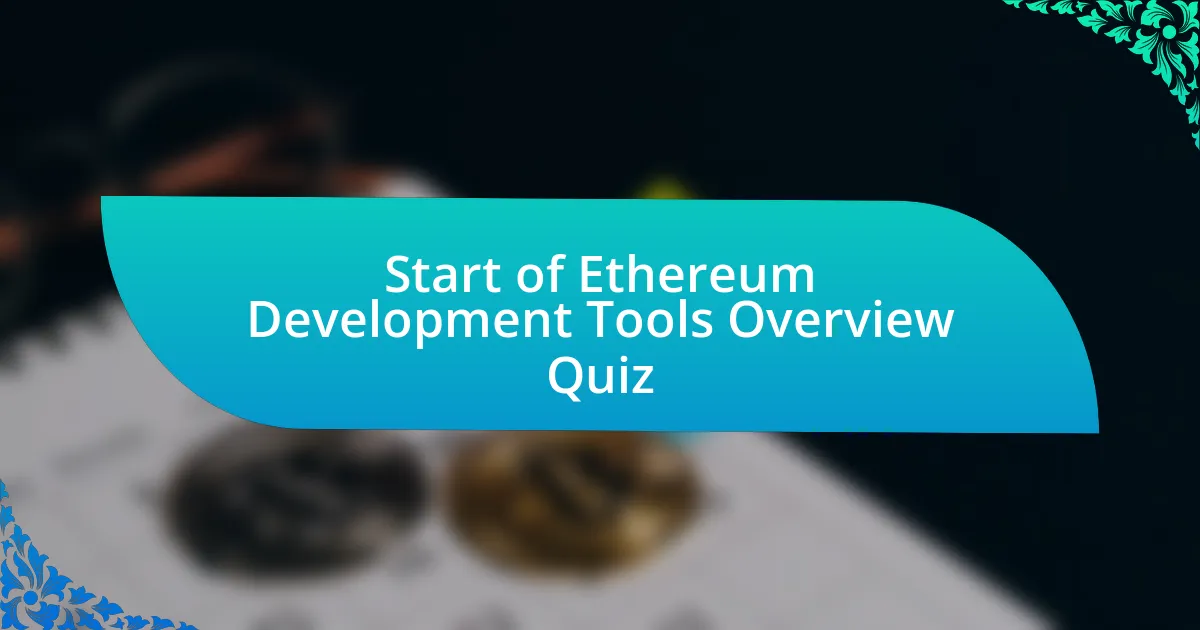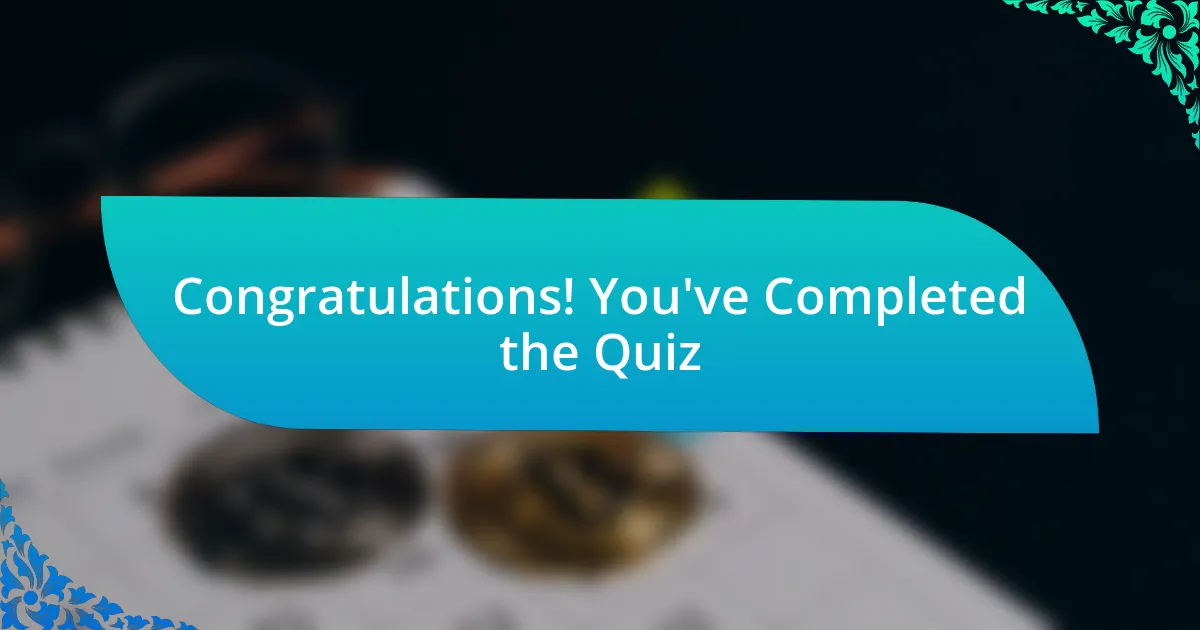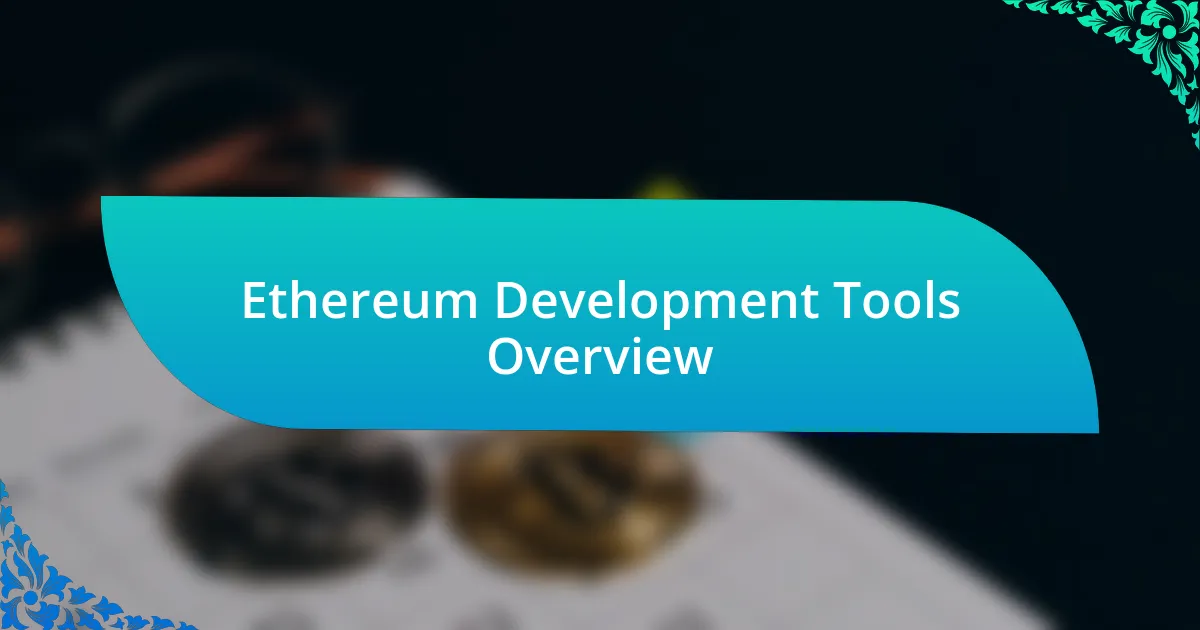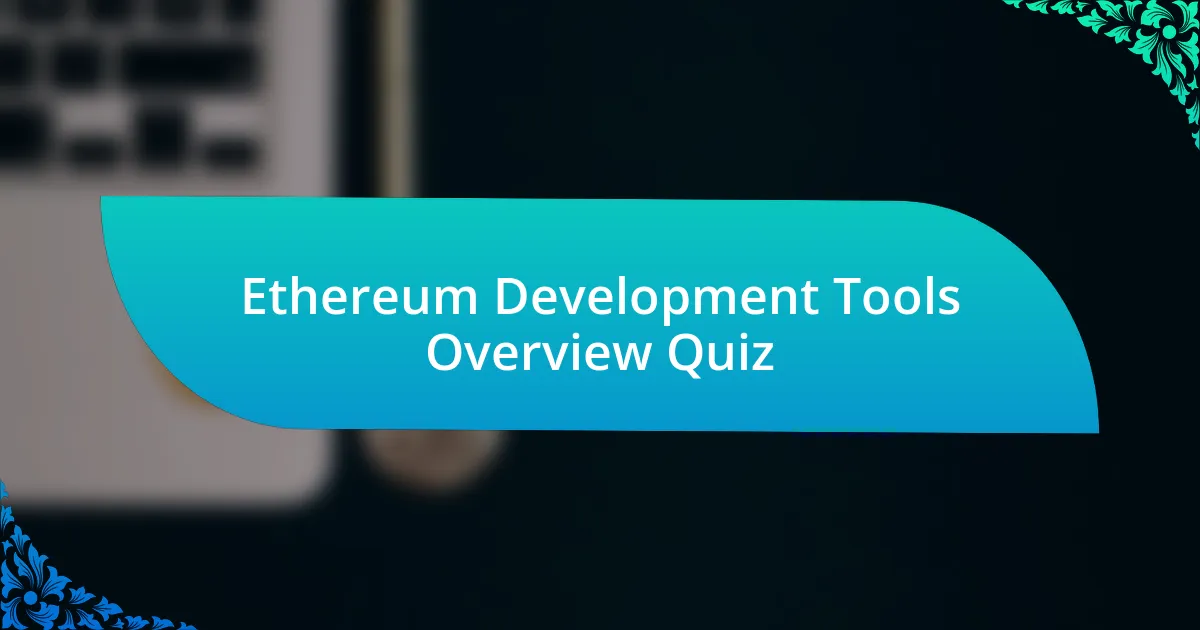
Start of Ethereum Development Tools Overview Quiz
1. What does Truffle primarily support in Ethereum development?
- Web design
- Smart contract development
- Mobile app creation
- Game development
2. Which testing frameworks does Truffle integrate with?
- Jest and Jasmine
- Pytest and Unittest
- PHPUnit and Behat
- Mocha and Chai
3. How does Ganache assist developers in Ethereum?
- Ganache is a language for writing smart contracts.
- Ganache is a tool for visualizing Ethereum transactions.
- Ganache is a trading platform for Ethereum tokens.
- Ganache is a personal Ethereum blockchain used for development purposes.
4. What are the two versions of Ganache available?
- Ganache API and Ganache IDE
- Ganache UI and Ganache CLI
- Ganache Wallet and Ganache Explorer
- Ganache Cloud and Ganache Server
5. What purpose does the Remix IDE serve in Ethereum development?
- Remix IDE is a web-based integrated development environment for Solidity smart contract development.
- Remix IDE is a hardware wallet for securely storing cryptocurrency.
- Remix IDE is a centralized blockchain solution for processing transactions.
- Remix IDE is a mobile application for trading Ethereum tokens.
6. What key features enhance user experience in Remix IDE?
- User-friendly interface, quick access, and integrated testing.
- Complex setup, extended installation, and minimal functionality.
- Command-line only, no graphical interface, and limited features.
- Requires heavy installation, lacks debugging tools, and offline only.
7. How does Embark facilitate the development of dApps?
- Embark is a wallet that securely stores Ethereum and facilitates token swaps.
- Embark only focuses on improving transaction speeds for crypto transfers and payments.
- Embark helps in creating decentralized exchanges and trading platforms easily.
- Embark integrates with Ethereum blockchains and storage systems for seamless dApp development.
8. What does Embark automatically manage during contract deployment?
- Automatic redeployment of contracts
- Batch processing of transactions
- Code optimization for dApps
- Manual testing of contracts
9. What type of applications does Drizzle enhance?
- Decentralized applications
- Mobile applications
- Desktop applications
- Web browser extensions
10. What advantages does Drizzle offer for front-end development?
- Requires a separate server for deployment.
- Complex setup process compared to other libraries.
- Convenient and predictable dApp development with front-end support.
- Limited access to blockchain data and services.
11. What language is primarily used in Hardhat development?
- Ruby
- C++
- Python
- JavaScript
12. What is a significant feature of Hardhat`s debugging capabilities?
- Advanced Debugging
- Simplified User Interface
- Automatic Contract Deployment
- Local Storage
13. What kind of developers benefit from using Brownie?
- Python developers
- Ruby developers
- Java developers
- C++ developers
14. What is the primary programming language integrated with Brownie?
- Java
- Python
- Ruby
- C++
15. How does Web3.js facilitate Ethereum network interactions?
- Web3.js generates cryptocurrency mining solutions for Ethereum.
- Web3.js creates unique non-fungible tokens for Ethereum.
- Web3.js provides a set of JavaScript libraries for Ethereum interaction.
- Web3.js is only a wallet application for managing Ether.
16. What key functionalities are provided by Ethers.js?
- Integrated development environment, debugging tools, and user interface design.
- Wallet management, transaction signing, and contract interaction.
- Smart contract deployment, scaling solutions, and data storage.
- Token minting, blockchain encryption, and governance voting.
17. How does Infura support Ethereum developers?
- Infura is a decentralized exchange for trading Ethereum tokens.
- Infura offers a wallet service for managing Ethereum assets.
- Infura provides reliable network access for Ethereum development, allowing developers to interact with the Ethereum network securely.
- Infura is a mining pool that helps users mine Ethereum more effectively.
18. What tools are commonly used for testing smart contracts?
- MetaMask
- Geth
- Infura
- Truffle
19. What cryptocurrency is represented by ETH?
- Ethanol
- Ethereum Coin
- Ether
- Ethers
20. What is the primary language used to write smart contracts on Ethereum?
- Solidity
- JavaScript
- Python
- C++
21. Name a few alternative smart contract programming languages to Solidity.
- Kotlin
- Ruby
- Vyper
- Java
22. What is the primary function of the Ethereum Virtual Machine (EVM)?
- The primary function is executing smart contracts.
- The primary function is managing user wallets.
- The primary function is creating new cryptocurrencies.
- The primary function is facilitating peer-to-peer transactions.
23. How does Truffle implement automated testing in smart contracts?
- Truffle executes automatic tests only in Python language.
- Truffle performs automated tests both in JavaScript and Solidity, using frameworks like Mocha and Chai.
- Truffle only supports manual testing using command line inputs.
- Truffle employs external services to conduct all automated testing.
24. What does the TruffleSuite enable for developers?
- Functions as a wallet for storing Ether securely.
- Manages Ethereum node infrastructure for developers.
- Provides a complete environment for smart contract development.
- Offers a marketplace for selling dApps and contracts.
25. What is the functionality of Ganache CLI for developers?
- Ganache CLI is a cryptocurrency trading platform.
- Ganache CLI is a command-line tool for Ethereum development.
- Ganache CLI is a wallet for storing Ethereum.
- Ganache CLI is an educational resource for blockchain concepts.
26. How does Remix IDE provide feedback during coding?
- Slow compilation and debugging processes
- Offline coding without error reports
- Mandatory code reviews by peers
- Real-time code analysis and error feedback
27. What options does Remix IDE offer for deploying contracts?
- Easy deployment to various Ethereum networks.
- Automatic generation of front-end UI for dApps.
- Direct compilation of Solidity to JavaScript.
- Built-in wallet for managing Ether transactions.
28. What are some drawbacks of using Remix IDE?
- Inability to connect to other blockchain networks.
- High cost of deployment on Ethereum mainnet.
- Limited scalability and performance issues due to browser dependency.
- Lack of support for smart contract development.
29. Why might developers use a private Ethereum network?
- To enhance public visibility and transparency.
- To increase transaction fees and costs.
- For generating random Ether rewards.
- For data privacy and permission testing.
30. What is the role of MetaMask in Ethereum development?
- MetaMask is a blockchain technology that enhances scalability and performance.
- MetaMask is a popular browser-based Ethereum wallet used to interact with dApps on the Ethereum network.
- MetaMask is a programming language used for developing smart contracts.
- MetaMask is a cryptocurrency exchange platform for trading Ether.

Congratulations! You’ve Completed the Quiz
Thank you for participating in our quiz on Ethereum Development Tools Overview. We hope you found it informative and engaging. By completing this quiz, you’ve likely gained valuable insights into the various tools used for Ethereum development, such as IDEs, testing frameworks, and deployment tools. Understanding these elements is crucial for anyone looking to build applications on the Ethereum blockchain.
This quiz has covered key concepts that could benefit your development journey. You may have learned about the differences between popular frameworks, the importance of testing in smart contract development, and how these tools can streamline the deployment process. Such knowledge empowers you to make informed decisions in your projects.
If you’re eager to expand your knowledge further, we invite you to explore the next section on this page. It delves deeper into Ethereum development tools, providing tips, best practices, and more detailed information. Enhancing your understanding of these tools can significantly impact your success in Ethereum development.

Ethereum Development Tools Overview
Introduction to Ethereum Development Tools
Ethereum development tools are software applications and frameworks that facilitate building, testing, and deploying decentralized applications (dApps) on the Ethereum blockchain. They provide developers with essential functionalities such as smart contract management, debugging, and transaction simulation. Popular examples include Truffle, Hardhat, and Remix, which are designed to streamline the development process.
Smart Contract Development Frameworks
Smart contract development frameworks are specialized tools used for writing, compiling, and testing smart contracts on Ethereum. Truffle and Hardhat are two leading frameworks that offer features such as automated testing, scripting, and deployment management. These frameworks provide essential libraries and tools that reduce development time and enhance the quality of smart contracts.
Integrated Development Environments (IDEs)
Integrated Development Environments (IDEs) for Ethereum, like Remix, are web-based platforms that allow developers to write, test, and deploy smart contracts directly in the browser. They offer a user-friendly interface with built-in features like code highlighting, debugging tools, and compilation feedback, making it easier for both beginners and experienced developers to work on smart contracts.
Testing and Debugging Tools
Testing and debugging tools are critical for ensuring the reliability and security of Ethereum applications. Tools such as Ganache provide a personal blockchain for testing, while tools like MythX and Slither assist in detecting vulnerabilities in smart contracts. These tools help developers identify issues before deployment, thus enhancing the overall security of dApps.
Blockchain Client Libraries
Blockchain client libraries, such as Web3.js and Ether.js, enable developers to interact with the Ethereum blockchain from their applications. These libraries provide comprehensive APIs for functions like sending transactions, querying data, and interacting with smart contracts. They are essential for integrating dApps with the Ethereum network, allowing seamless communication between the components of decentralized systems.
What are Ethereum development tools?
Ethereum development tools are software applications and frameworks that facilitate the development, testing, and deployment of decentralized applications (dApps) on the Ethereum blockchain. They include environments like Truffle and Hardhat for smart contract development, Ganache for local blockchain simulation, and Metamask for managing user wallets and transactions. These tools streamline the development process, making it easier for developers to build, test, and execute contracts on the Ethereum network.
How do Ethereum development tools work?
Ethereum development tools work by providing developers with functionalities like smart contract compilation, testing, and deployment automation. For example, frameworks such as Truffle offer built-in libraries, testing environments, and deployment scripts to deploy contracts directly to the network. Additionally, tools like Remix provide an integrated development environment where developers can write, debug, and test smart contracts instantly within their web browsers. This enhances the efficiency and reliability of the development process.
Where can you find Ethereum development tools?
Ethereum development tools can be found on official websites, GitHub repositories, and various online communities. Popular resources include the Truffle Suite website, the Hardhat documentation, and the Remix IDE website. Additionally, many tools are open-source and available for download on GitHub, making them accessible to developers worldwide. Online platforms like Stack Overflow and Ethereum forums also serve as valuable locations for discovering and discussing these tools.
When should developers use Ethereum development tools?
Developers should use Ethereum development tools at the beginning of their dApp development process and throughout its lifecycle. This includes stages such as writing smart contracts, testing them, and deploying them to the Ethereum network. Utilizing these tools from the start helps to identify issues, streamline code management, and ensure more efficient deployment. Notably, timely usage can also enhance smart contract security, reducing vulnerabilities before they go live.
Who are the main contributors to Ethereum development tools?
The main contributors to Ethereum development tools include individual developers, startups, and established organizations within the blockchain ecosystem. Some notable contributors are ConsenSys, which develops various tools for the Ethereum ecosystem, and the Ethereum Foundation, which supports core development. Additionally, many open-source contributors collaborate on platforms like GitHub, improving and updating these tools continuously. Their collective efforts help foster innovation in Ethereum development.

